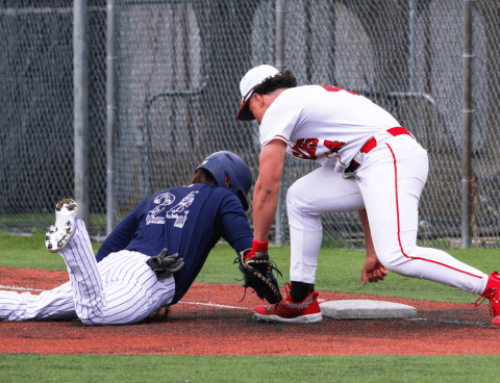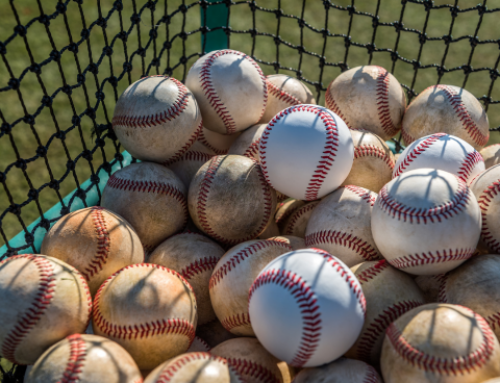Baseball Catcher Drills and Technique, Part 3

Thinkstock
Catch up on Part 1 and 2 of this series.
If you’re a catcher who wants to improve your game, you must learn to shut down your opponent’s baserunners. Here are some techniques and drills to help you reach that goal.
Make every throw with a four-seam grip—with two fingers and your thumb on the baseball. To chart throws, time the baseball from when it reaches your mitt until it reaches the fielder’s glove. Two seconds is a great time for throws to second base on 90-foot base paths. Footwork is vital to throwing accurately and quickly. Most professionals have a 1.8- to 2.0-second “pop time.”
That said, your throws will depend on the situation.
Catcher Scenarios
1. Ball bunted down the third-base line
Turn your back to first and pivot on your right foot to throw to first. Always field the ball between your feet along the mid-line of your body. Rake the bunt with two hands, using your glove and bare hand. Take a step with your right foot then left foot to throw the ball, staying low. Continue a few steps toward the base you’re throwing to. Make this part of your weekly catcher drills.
2. When a runner is on base
Cheat with your feet as the ball approaches the mitt from the pitcher. Turn your body to simultaneously catch the ball and step with your right foot directly underneath the glove. Your left foot needs to come down in line with the instep of your right foot toward the intended target. After you receive the ball, exchange it from your glove to your throwing hand close to your ear. The glove side elbow serves as a “scope” for you to aim at the target. As you throw the ball, your glove retracts toward your ribs. Use footwork, leg strength, core strength and arm strength—in that order—to maintain a healthy throwing arm.
3. Throwing to first or second base
Use similar footwork to N0. 2, but position your feet to point toward the new target. It doesn’t matter how quick you are if you’re not accurate.
4. Throwing to third base with a right-handed batter in the box
When you have to throw to third base with a right-handed batter in the box, it’s up to you to determine whether the ball will be caught over the inner third of the plate, forcing you to throw behind the batter. If the pitch is over the middle or outer third of the plate, you must go in front of the batter. The right foot comes down directly underneath the glove with the left foot in line with the instep of the right foot and with the target.
5. Throwing with runners on first and third.
You must determine how far the runner at third base is off the bag before throwing the ball to second for the putout. How far off the bag the runner is and where his chest is pointed (toward home, the infield or back to third base) will typically tell you whether the runner at third is planning to take off for home. The third baseman can assist by placing his hands in the air if he feels you should pick the runner off at third rather than throw to second.
RELATED: Developing Trust Between Pitcher and Catcher
Catcher Drills
- Catching the ball and throwing with a four seam grip every time.
- The exchange of the ball from the mitt to a grip with two fingers and a thumb.
- Work on footwork on a line, ensuring that your feet are in line with your target.
- Improve accuracy by having your throwing partner receive the ball waist-high, with his glove open as a target.
Catcher Workout
- Jump rope for one minute as fast as possible, resting for 30 seconds. Repeat twice.
- Do four to six Broad Jumps as far as possible to build explosiveness.
- Box Jumps on a 12-inch box. Jump onto the box and step down before repeating the next jump. Complete one minute of jumps, then rest for 30 seconds. Repeat twice.
- Med Ball Figure Eight Throws. 10 throws each side
- Med Ball Backwards Toss. 10 throws
- Med Ball Back Slam. 10 repetitions
RECOMMENDED FOR YOU
MOST POPULAR
Baseball Catcher Drills and Technique, Part 3

Thinkstock
Catch up on Part 1 and 2 of this series.
If you’re a catcher who wants to improve your game, you must learn to shut down your opponent’s baserunners. Here are some techniques and drills to help you reach that goal.
Make every throw with a four-seam grip—with two fingers and your thumb on the baseball. To chart throws, time the baseball from when it reaches your mitt until it reaches the fielder’s glove. Two seconds is a great time for throws to second base on 90-foot base paths. Footwork is vital to throwing accurately and quickly. Most professionals have a 1.8- to 2.0-second “pop time.”
That said, your throws will depend on the situation.
Catcher Scenarios
1. Ball bunted down the third-base line
Turn your back to first and pivot on your right foot to throw to first. Always field the ball between your feet along the mid-line of your body. Rake the bunt with two hands, using your glove and bare hand. Take a step with your right foot then left foot to throw the ball, staying low. Continue a few steps toward the base you’re throwing to. Make this part of your weekly catcher drills.
2. When a runner is on base
Cheat with your feet as the ball approaches the mitt from the pitcher. Turn your body to simultaneously catch the ball and step with your right foot directly underneath the glove. Your left foot needs to come down in line with the instep of your right foot toward the intended target. After you receive the ball, exchange it from your glove to your throwing hand close to your ear. The glove side elbow serves as a “scope” for you to aim at the target. As you throw the ball, your glove retracts toward your ribs. Use footwork, leg strength, core strength and arm strength—in that order—to maintain a healthy throwing arm.
3. Throwing to first or second base
Use similar footwork to N0. 2, but position your feet to point toward the new target. It doesn’t matter how quick you are if you’re not accurate.
4. Throwing to third base with a right-handed batter in the box
When you have to throw to third base with a right-handed batter in the box, it’s up to you to determine whether the ball will be caught over the inner third of the plate, forcing you to throw behind the batter. If the pitch is over the middle or outer third of the plate, you must go in front of the batter. The right foot comes down directly underneath the glove with the left foot in line with the instep of the right foot and with the target.
5. Throwing with runners on first and third.
You must determine how far the runner at third base is off the bag before throwing the ball to second for the putout. How far off the bag the runner is and where his chest is pointed (toward home, the infield or back to third base) will typically tell you whether the runner at third is planning to take off for home. The third baseman can assist by placing his hands in the air if he feels you should pick the runner off at third rather than throw to second.
RELATED: Developing Trust Between Pitcher and Catcher
Catcher Drills
- Catching the ball and throwing with a four seam grip every time.
- The exchange of the ball from the mitt to a grip with two fingers and a thumb.
- Work on footwork on a line, ensuring that your feet are in line with your target.
- Improve accuracy by having your throwing partner receive the ball waist-high, with his glove open as a target.
Catcher Workout
- Jump rope for one minute as fast as possible, resting for 30 seconds. Repeat twice.
- Do four to six Broad Jumps as far as possible to build explosiveness.
- Box Jumps on a 12-inch box. Jump onto the box and step down before repeating the next jump. Complete one minute of jumps, then rest for 30 seconds. Repeat twice.
- Med Ball Figure Eight Throws. 10 throws each side
- Med Ball Backwards Toss. 10 throws
- Med Ball Back Slam. 10 repetitions











